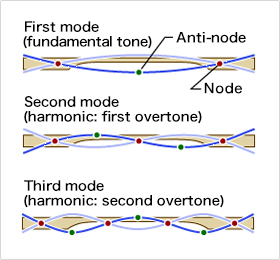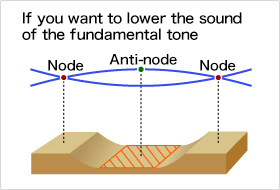The Structure of the Marimba
There is craft to the design of the tone plates, too
The underside is sanded?
The marimba is an instrument that produces notes with wooden tone plates and then makes those notes richer with metal resonator pipes.
Essentially, there are two methods of adjusting how high the notes produced by the tone plates are. For one, the size of the tone plates can be adjusted. The lower the note, the longer the tone plate, and also the greater the breadth. The other method used is to sand down the underside. The pitch and timbre of the tone plate will change depending on the part that is sanded and the amount that is removed. Basically, the more the central portion of the tone plate is sanded, the lower the note produced.
Tune the harmonics, not just the fundamental tone
The point of sanding the underside of the tone plate is not merely to adjust it so that hitting the C bar produces a C note. It is also related to the tuning of the harmonics.
When the tone plate is struck with a mallet, it vibrates in various ways each strike. The figure is a diagram that displays how this works. Within each vibration, the points where the movement is the greatest are called the anti-nodes, and the fulcrum points of the vibration that do not move are called nodes. Within the diagram, the first-mode oscillation, in which the center of the wave goes significantly up and down, is the vibration of the fundamental tone.
The fundamental tone is the sound that forms the basis for a tone. It is the note shown on a musical score; if the fundamental tone is a C, then it will be a C note. In addition to the fundamental tone, the tone plate also produces several vibrations consisting of more finely grained waves. These are harmonic vibrations.
When tuning the tone plate, adjustments must be made for these harmonics, as well.

Vibrational modes of a tone-plate percussion instrument
How do you tune the harmonics of a marimba?
Harmonics are tones that sound at the same time as the fundamental tone. They have frequencies that are even multiples of the fundamental tone's frequency. Several harmonics sound out at once, becoming some of the elements that give rise to timbre. The low end of the concert marimba is tuned so that the first harmonic has a frequency that is four times that of the fundamental tone, and the next harmonic has one that is 10 times the frequency. If the fundamental tone is a C, then the first harmonic is the C two octaves higher, and the next harmonic is slightly more than one octave higher, an E. Try hitting the C tone plate and the tone plate for its harmonic E in alternation. It should be clear that the E tone is audible within the C note.

If the fundamental tone is C
To lower the pitch of the fundamental tone, sand down the anti-node
The pitch of tone plates is tuned using the principle that the note will be lower if the underside is sanded down. However, if a bar has been sanded down too much there is no way to return it to the way it was before, so care must be taken. Due to the characteristics of the bar, removing material from the anti-node on the inside surface of the tone plate lowers the pitch more than removing it from the nodes at either end. That is, if you want to lower the sound of the fundamental tone, you should sand down the anti-node portion in the center of the tone plate until it is concave.

If you want to lower the sound of the fundamental tone
Sanding tone plates is virtually a puzzle
For fundamental tones, the pitch will be lower if any place within the interior of the bar, away from the nodes, is sanded down. Taking the tuning of the harmonics into consideration, however, how to sand is not so simple. The complexity arises because vibrational modes relating to the harmonics cause the locations of the anti-nodes and nodes to change. The result of sanding to match one vibrational mode may be effects on other vibrational modes. That is, moving the pitch of one harmonic will also alter other harmonics and the fundamental pitch.
Making all three of the fundamental tone, fourth harmonic, and 10th harmonic of just one tone plate match requires practiced skill. The process of tuning is truly like completing a puzzle.
Pay attention to the grain of the wood
Marimba tone plates use wood, but wood is not a homogeneous material: it has a grain. Based on the structure of the grain, a single bar will have differences in how high pitched the sound produced is, depending on the exact spot. To remedy this, different sanding techniques are used for positions where the sound is higher and where it is lower, creating a single pitch for that particular tone plate.
Because the grain of the wood always differs, the undersides of tone plates are not all sanded the same way, even when they are intended to play the same note.
The timbre will vary with the location struck
A finished tone plate will produce the same fundamental tone wherever it is struck. That is, the pitch will be the same. However, the timbre will vary with the location struck. This is because, depending on the location, some harmonics will come out more easily, and the balance among the fundamental tone, the fourth harmonic, and the 10th harmonic will change. Thus, the marimba can express a rich variety of shifting timbres.




*The resonator pipes have been removed for the recording to make the note easier to distinguish.
Musical Instrument Guide : Marimba Contents
Origins
Structure
- What kind of instrument is the marimba?
- Inside and outside the resonator pipes
- There is craft to the design of the tone plates, too
- [Experiment1]Tone plate sanding depth and sound pitch experiment
- [Experiment2]Tone plate sanding location and sound pitch experiment
- [Experiment3]Try changing the material of the resonator pipes
